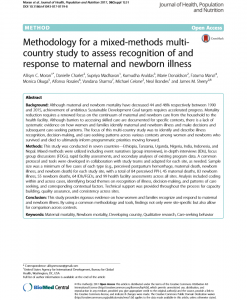
Although maternal and newborn mortality have decreased 44 and 46% respectively between 1990 and 2015, achievement of ambitious Sustainable Development Goal targets requires accelerated progress. Mortality reduction requires a renewed focus on the continuum of maternal and newborn care from the household to the health facility. Although barriers to accessing skilled care are documented for specific contexts, there is a lack of systematic evidence on how women and families identify maternal and newborn illness and make decisions and subsequent care-seeking patterns. The focus of this multi-country study was to identify and describe illness recognition, decision-making, and care-seeking patterns across various contexts among women and newborns who survived and died to ultimately inform programmatic priorities moving forward.
This study was conducted in seven countries—Ethiopia, Tanzania, Uganda, Nigeria, India, Indonesia, and Nepal. Mixed-methods were utilized including event narratives (group interviews), in-depth interviews (IDIs), focus group discussions (FDGs), rapid facility assessments, and secondary analyses of existing program data. A common protocol and tools were developed in collaboration with study teams and adapted for each site, as needed. Sample size was a minimum of five cases of each type (e.g., perceived postpartum hemorrhage, maternal death, newborn illness, and newborn death) for each study site, with a total of 84 perceived PPH, 45 maternal deaths, 83 newborn illness, 55 newborn deaths, 64 IDIs/FGDs, and 99 health facility assessments across all sites. Analysis included coding within and across cases, identifying broad themes on recognition of illness, decision-making, and patterns of care seeking, and corresponding contextual factors. Technical support was provided throughout the process for capacity building, quality assurance, and consistency across sites.
This study provides rigorous evidence on how women and families recognize and respond to maternal and newborn illness. By using a common methodology and tools, findings not only were site-specific but also allow for comparison across contexts.